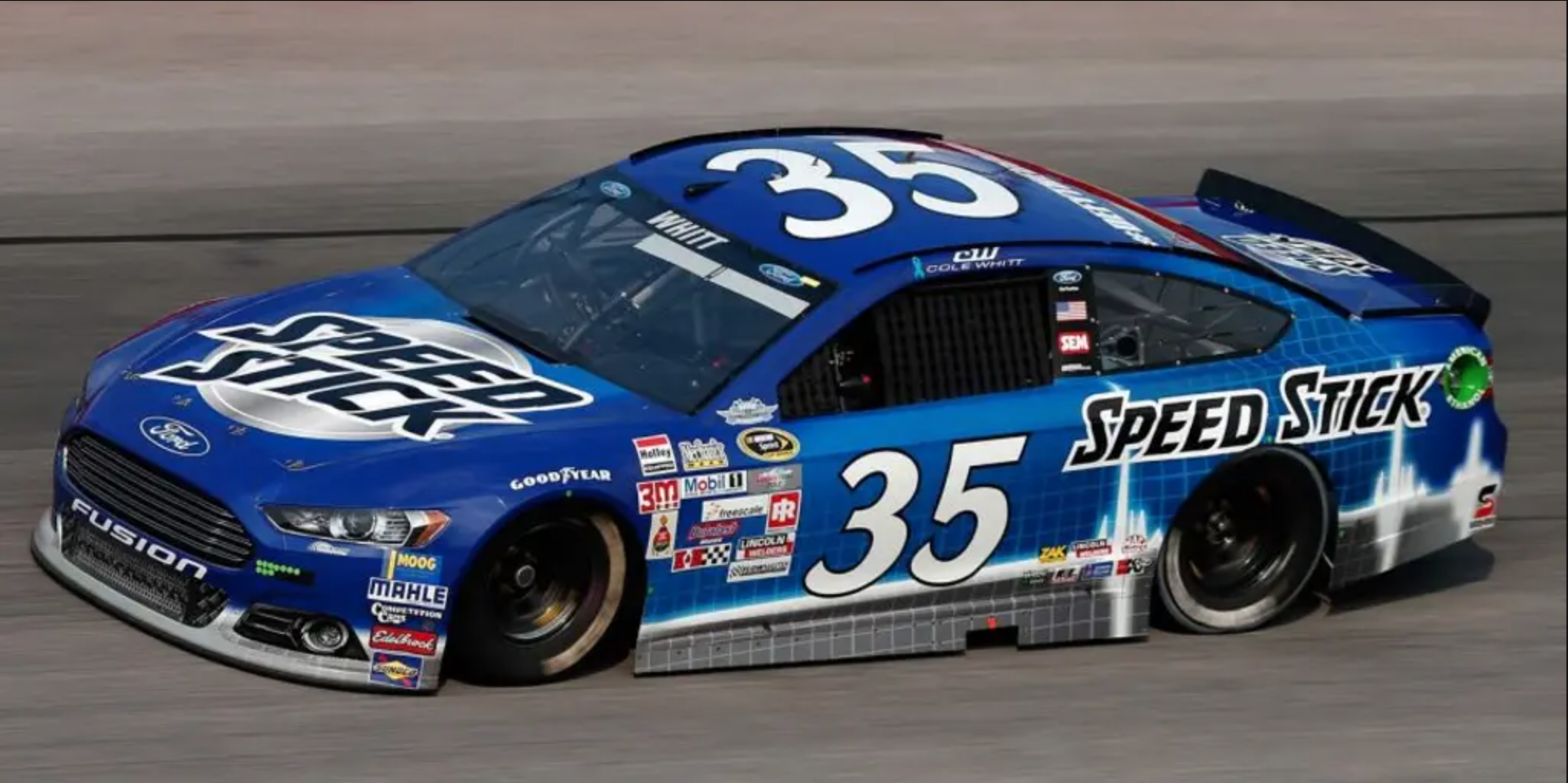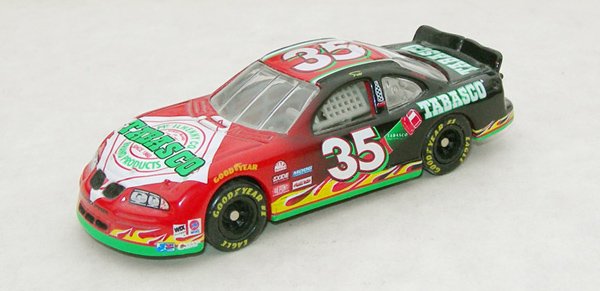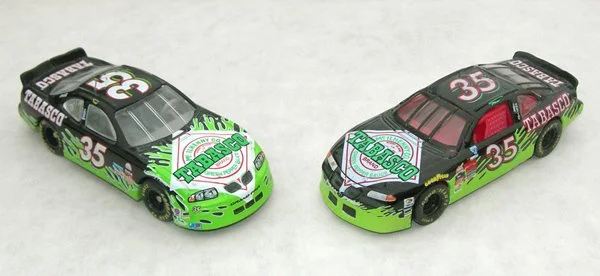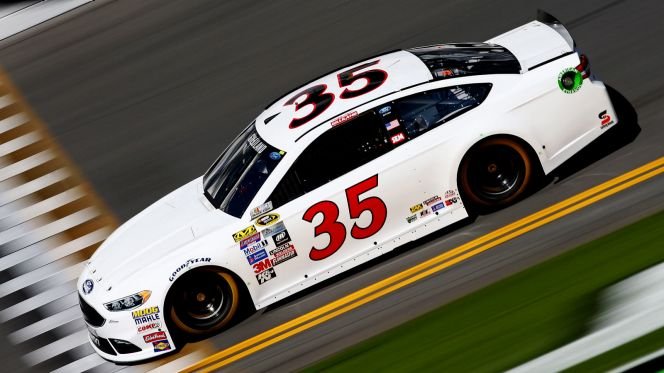
In NASCAR Cup Series competition the #35 car has started 318 races with 76 drivers and has 0 wins, 1 pole, 11 top 5s, 35 top 10s, and 115 DNFs.
1997-1998 saw the “Tabasco Fiasco ” unfold with the newly founded International Sports Management team and drivers Todd Bodine, Darrell Waltrip, Wally Dallenbach, and Gary Bradberry.
A summary of the “Tabasco Fiasco” from papiotom.com
TOO HOT TO HANDLE
If anything characterizes the changing face of NASCAR racing it is the so-called “TABASCO FIASCO” (a phrase first coined on television by Darrell Waltrip at Motegi, Japan in 1999).
The story began in Charlotte, NC in October, 1997, where a newly-created team called international Sports Management proudly introduced a new TABASCO Pontiac race car. Todd Bodine was signed on to drive, backed by heavy-duty marketing schemes involving the TABASCO sponsorship. The spiffy new livery appeared at that weekend’s race and did okay, making the field and finishing 26th. Over the winter, everyone sat back in anticipation of great things to come in 1998. Monogram Models issued a Limited Edition model kit based on the 1997 Charlotte car, while Revell, Hot Wheels, and Racing Champions all began creating diecast TABASCO cars. Todd got a two-page spread in 1998’s Official NASCAR Preview and Press Guide, where he was “predicted by many to be one of the hottest teams of the 1998 season”.
The optimism of the 1997 introduction quickly turned to desperation when the 1998 season actually began. Being a new team, ISM didn’t have previous owner’s points, necessary to receive a provisional qualifying position – they had to make the Daytona 500 field with speed. The car failed to qualify. The next week at Rockingham, the car failed to qualify. But the next week, at Las Vegas… the car failed to qualify. No concerns were voiced by TABASCO – they were patient.
Finally, for the fourth race of the season, at Atlanta, the team qualified – on the front row – and despite a late-race engine problem, finished with a strong tenth-place run. And then at Darlington… they failed to qualify. They did make the field at Bristol at the end of March, finishing 29th. The TABASCO car had only been seen in two of the first six races. Poor Todd couldn’t get into the field enough to keep the TABASCO name front and center, but the TABASCO folk had already jumped into the merchandizing with both feet – there was even a Todd Bodine cookbook.
So then at Texas, they failed to qualify. They got a 39th place (fourth from last) finish at Martinsville, then continued not qualifying for the prestigious Diehard 500 at Talledega in late April. A practice accident took Todd out of the California race, where Wally Dallenbach started the car in the last position and finished 29th. Todd was back on board for the Coca Cola 600 in late May, finishing 28th.
June 6th saw Todd’s last ride in the TABASCO Pontiac, at Richmond. In his brief tenure, the TABASCO car had managed to make the field in only five of the first thirteen races.
The owner, Bob Hancher’s International Sports Management, was desperate to do something to turn the season around. In a solution typical of modern management, ISM dumped Todd after failing to qualify for the June Pocono race, and Gary Bradberry appeared at New Hampshire in July. There had been no consultation with TABASCO, and the sponsor was not pleased! Win races be damned – what about all the marketing they had built around Todd?
There appeared to be no saviour with a heavy foot in the wings… and a succession of new drivers, along with a brief manufacturer change, led into the depths of the “Tabasco Fiasco”.
DARRELL WALTRIP’S “ONE RACE WONDER” MONTE CARLO
Loy Allen had been tapped to replace Todd Bodine at the Firecracker 400 in July, but that race was postponed to October due to wildfires throughout the state of Florida. When racing resumed the following week, Gary Bradberry was unavailable, so Jimmy Horton was hired as driver… and failed to qualify for the July Pocono race. Wally Dallenbach was offered a five-race deal, but turned it down. Now no other replacement driver for the TABASCO team had been named, and the Brickyard 400 was coming up.
Meanwhile, in another far-away galaxy of the NASCAR universe, Darrell Waltrip’s Western Auto world had been quickly unravelling. He complained that his new sponsor, Speedblock, had not even remotely lived up to its commitments, and Waltrip was running the team out of his own pockets. Even DW’s pockets weren’t deep enough to keep that up for long, and he sold his unsponsored team to Tim Beverley, who shut it down in order to regroup as Tyler Jet Motorsports… while DW moved on.
DW had some good times driving Teresa Earnhardt’s PENNZOIL Chevy in place of the injured Steve Park, but by the time the Brickyard rolled around, Park was back in good health, and DW had no ride.
Tim Beverly, a wealthy industrialist who builds and sells airplanes, had meanwhile purchased the TABASCO team from International Sports Management prior to the Brickyard – again, ISM hadn’t bothered to tell the sponsors. So now Beverly owned both Waltrip’s old unsponsored team and the TABASCO team. Beverly put Darrell in one of the new Tyler Jet Chevrolets that had been built by DW’s old team over the past few weeks. Since Beverly owned both teams, he opted to field a Tyler Jet Chevy as the TABASCO-sponsored entry, feeling it would be superior to the Pontiacs ISM had been running for TABASCO.
So, just prior to the Indy event, a crew took some decals and paint from the ISM team, tootled over to DW’s old shop, now Tyler Jet, and repainted a Monte Carlo in the TABASCO colour scheme. Now TABASCO not only had a new driver, but even the Pontiacs featured in their marketing were disappearing! Darrell Waltrip was driving the TABASCO Chevrolet, but all the merchandise in stores featured Todd Bodine’s TABASCO Pontiac. McIlhenny, the corporate owners of TABASCO, were livid.
Waltrip ran the Monte Carlo in TABASCO livery at Indy, and finished 13th, the second-best finish ever for the TABASCO-sponsored team. Although called a “one-race wonder”, Waltrip also ran a Tyler Jet Chevy the next week at Watkins Glen, finishing 25th, before TABASCO insisted they go back to the Pontiacs – and began rethinking NASCAR sponsorship.
DW languished for the rest of 1998, driving the bog-slow Pontiacs, usually getting into the field by relying on Past Champion Provisionals… embarrassed (so he said later) but at least trying to meet TABASCO’s marketing objectives. Waltrip started dead last in all but two races and only cracked the top-20 once during that span.
At the end of 1998, both TABASCO and Darrell Waltrip were happy to be done with Tyler Jet Motorsports. The next spring, owner Tim Beverly had a new sponsor: the 10-10-345 Lucky Dog Phone Company, who requested Beverly change the team’s number from #35 to #45. Beverly struggled through another year and a half with a variety of different drivers and sponsors, but eventually sold the team outright to MB2 Motorsports.
It’s been fourteen years since the Tabasco Fiasco, but to this day, no full-time team has dared to run the #35 at NASCAR’s highest level. In 2004, a team owned by Gary Keller attempted a few races with Mike Wallace driving an unsponsored number 35 car.
It never qualified.
THE “BOTTLE” PONTIAC
Although the saga of Todd Bodine and TABASCO in 1998 is quickly receding into NASCAR obscurity, he managed three different colour schemes in his brief tenure. Shown here is the one-time paint scheme he used in the 1998 BUD SHOOTOUT, known as the “Bottle” car.
The 1998 Bud Shootout was won by Rusty Wallace (in the “Adventures of Rusty” car), with drafting help from brother Kenny. Todd started the “Bottle” car in 6th, and finished 10th. Not a bad start to the year (he’d made the race thanks to taking the pole at Watkins Glen the year before, driving the #34 Hardinge Chevy)… but it was all downhill from there in 1998 for Todd and Team Tabasco. And the Bud Shootout wasn’t a points-paying race.
By September, Todd Bodine was driving the #91 Joe Falk-owned car in the Busch series. He finished fifth at Atlanta to conclude the season.
THE “GREEN SAUCE” PONTIAC
Generally, if Todd Bodine and TABASCO in 1998 are remembered at all, they are associated with bright orange/white Pontiacs. With this episode of Todd’s NASCAR career now slowly fading into history, the “Green Sauce” car is likely only remembered by diehard fans and diecast collectors.
Todd drove the “green sauce” car several times in 1998. In the March Atlanta race he started on the outside of row one and led the biggest part of the first half of the race. An engine problem later on caused him to finish 10th, a lap down, and that ended up being the best result the TABASCO team ever put together.
[Pictured] Obvious differences between the Racing Champions™ car on the left and the Hot Wheels™ model
Josh Wise has the second most starts in #35, appropriately with 35. Josh Wise drove the #35 for Front Row Motorsports for every race in 2013, except for the race at Watkins Glen where Michael McDowell drove the car. Unfortunately, due to lack of consistent sponsorship Wise was forced to race as a “start and park” driver for much of 2013, finishing the year with 16 DNFs. At the end of the 2013 season Wise parted ways with Front Row to join Phil Parsons Racing .
Following the departure of Wise, Front Row Motorsports stopped fielding the #35 full time to focus on the efforts of the #34 & #38. The #35 was fielded 4 times in 2014 with drivers David Reutimann and Blake Koch.
Front Row revived the #35 again as a full time entry for the 2015 season with driver Cole Whitt. Speed stick signed on to sponsor the car for many of the 36 race schedule. Whitt has the most starts in #35 after starting all 36 events of the 2015 season.
In 2016 Front Row Discontinued the #35 as a full-time team, but attempted all 4 restrictor plate races with their former driver David Gilliland behind the wheel. Gilliland qualified for 2 of these races.
Benny Parsons ran 29 races in the 1987 season with Hendrick Motorsports a substitute for driver Tim Richmond, who was stricken with AIDS and would succumb in 1989. During the first lap of a race at Darlington Raceway, Parsons hit the wall and badly damaged his race car. He was able to continue, but had to make several pit stops for repairs. At one point, his crew chief, Harry Hyde refused to allow Parsons to pit because he and the crew were on an ice cream break. This incident was alluded to in the film, Days of Thunder. Another scene in the film was inspired by a real-life incident at Martinsville Speedway involving Parsons and the notoriously cantankerous Hyde: Hyde sarcastically told Parsons to hit the pace car on a restart because it was the only thing on the track Parsons had not hit. Both incidents are in the following clip of the movie.
In 1986 Alan Kulwicki ran his 22 race rookie season in #35 for Bill Terry. Following the season Terry sold his team to Kulwicki and Alan changed the number to #7. The rest is history.
From 1966-1967 Max Ledbetter drove #35 for 16 of his 21 career starts. No photo was found. Similarly, E.J. Trivette started 12 races in #35 from 1960-1961. No photo was found, and no other driver has more than 10 starts in the number.
Other notable names in #35
Bill Venturini, 7 starts
Jimmy Pardue, 4 starts
Bobby Hamilton Jr., 2 starts
Morgan Shepard, 2 starts
Tiny Lund 1 start
Joe Weatherly, 1 start
Jack Ingram, 1 start
Lee Petty, 1 start
Cutris Crider, 1 start
Cale Yarborough, 1 start
Jim Hirtubise, 1 start










